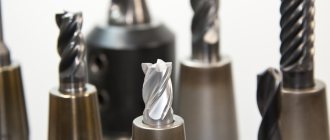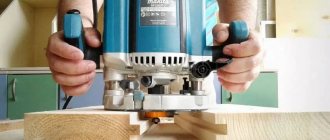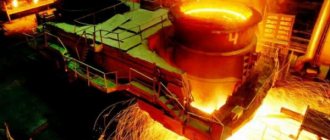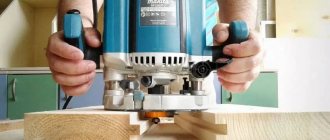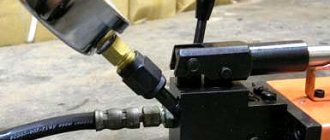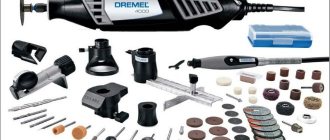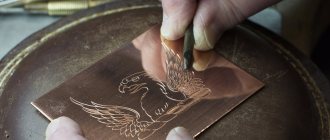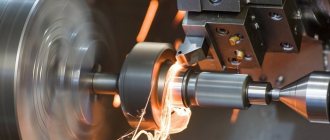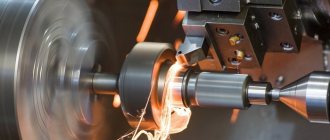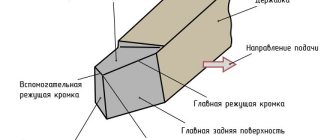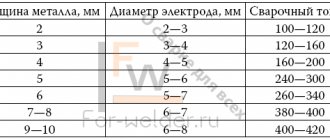23.03.2020
- Design and operating principle
- Classification of cutters: by what parameters
- Types of cutters for metal
- Classification of cutters according to some characteristics
- Nuances of choice
- Storage and operation rules
- Wide range of milling machine capabilities
During milling metalworking, it is important what type of metal cutter the master has chosen. In the article we will talk about the numerous varieties and features of their use - both a beginner and a professional will need this for repetition.
Design and operating principle
This tool is widely used on modern equipment to create a cut of any shape on a workpiece. This is a fairly optimal device that allows you to make holes, grooves, and also remove excess steel.
The tool unit is created from a durable tool alloy with maximum precision. To fulfill the parameters stated in the specifications, processing is used with an end tool with a large set of teeth - cutting inserts adjust the parameters to 1 micron.
Structurally, the cutter has several sharp working edges. Inserts are often made from diamond, ceramic and carded wire for durability.
The structure consists of:
- • Parts to work with.
- • Tail.
- • Center hole.
- • End teeth and grooves between them.
- • Necks in the middle.
Each tooth has, in turn, a front and rear surface, a cutting edge.
The operating principle is that the tool rotates quickly. At the same time, the workpiece moves. Upon contact, the top layer of steel is cut off mechanically under the influence of pressure.
Nuances of choice
On production sites, you usually don’t have to “guess” which actuator to use in a particular case. The technological map usually specifies both the material of the blank and the methods. When developing such documents, numerous factors are taken into account:
- geometric parameters;
- steel quality;
- sharpening angle;
- cutting characteristics (helical and straight cutters experience different loads and have different effects on the surface being processed);
- linear speed of meeting the cutting edge;
- attack dimensions;
- resistance to changes;
- temperature regime;
- cooling intensity;
- quality of the resulting products;
- sequence of application.
Let's assume that you want to do the processing yourself. If you do not delve into the intricacies of the process and use the tool in gentle modes, then all that remains is to select the appropriate capabilities for the required tasks. For example, for cutting, a disk of one thickness or another with a working edge on the outer radius is used. If it is necessary to accurately produce one of the lines of such a cut, then a similar gadget is used, but with two sharpened sides. Through grooves are made in a similar way (there is a place for entry and exit).
All motorists are familiar with the operation called “head grinding”. Its purpose is to form a plane on the part adjacent to the block. This is done with end cutting tools. Due to circular movements, characteristic spherical marks will be visible on the part.
For cavities, finger bits are used, as they can make cuts both end-on and side-on.
In a word, a special tool is selected for each technological action.
Types of cutters for metal
Usually, with versatile activities and numerous tasks, the milling machine operator has a complete set, and he himself knows perfectly well how they work. But newbies need to do a little review.
Disk
They are a disk with teeth. In this case, the cutting edges are either on one side or on both, depending on the purpose. During the metalworking stages (from roughing to finishing), the size of the notches may change. Carbide tools are used under difficult cutting conditions, when it is very difficult to remove chips from the work area. When to use this type of cutter:
- • for trimming edges or sawing;
- • for cutting grooves;
- • for chamfering, etc.
Accordingly, among the disk ones you can find cut-off, slotted and other subspecies. Let's talk about some of them that have design differences.
Double sided
The teeth of such discs are equipped with two cutting edges - a classic one on the end part, and also on a straight surface. This modification is more expensive and more productive.
Tripartite
Even more dangerous teeth - now they are equipped with three blades, that is, on each side - along the edges, at the ends and on top.
Grooved
There is only one edge, located on the working surface. The tool is suitable for not very deep and precise sampling of steel. It can be with a different number of teeth and depth of recesses. One common name for this type of cutter is dovetail. Why? Because the cutting zone has the shape of a truncated cone, like the feathers of a swallow.
End
From the name it is already clear that such a tool works with its side part. It is the ends of the cylinder (of different widths) that are equipped with blades that process the plane of the metal workpiece. The part is installed, respectively, perpendicular to the steel part.
Very often they come with removable plates, which saves the milling machine consumables. This is possible due to the overall massiveness of the structure. The advantages include:
- • Ease of working with flat elements, sheets and stepped surfaces.
- • High metal processing speed.
- • Smooth process.
Cylindrical cutters for metal - what are they?
Shape: cylinder. Quite a massive tool that is convenient for processing planes. This is the main type of equipment for both classic mechanical and CNC machines. The site has a large selection of milling equipment with a numerical control panel. A modern modification allows you to increase the speed and productivity of one workstation, as well as reduce the risk of errors due to the human factor.
Cylindrical tools can have different tooth shapes.
Direct
Less sought after and versatile, even rare. It is good and convenient, but for a very narrow profile of work: the equipment should be located parallel to the headers, and the metalworking area itself should have easy access and a flat surface. In general, such ideal conditions are rare - these are only narrow planes.
Screw
The most multifunctional, universal and, accordingly, in demand. The cutting lines do not go straight, but along a twisted spiral. The specified tilt angle may vary. Depending on the selected faces, virtually any selection can be made - on various parts. Peculiarities:
- • High effort during operation.
- • Possibility of using double tools when the edges are in opposite directions - this reduces the force acting on the edges.
A separate type of cutter is the “corn” cutter, which is used in the processing of ledges and the creation of grooves and their grinding. They look interesting.
Corner
This is a truncated cone that has sharp outer edges and tooth ends. The main purpose of use is metalworking of corners and uneven surfaces, removal of rectangular chamfers. They are also used to make chip flutes and many additional operations. The cutting edges are made with an inclination, which allows you to achieve any working angle. Let's see what subspecies there are.
Monolithic
The second name is all-metal. Their essence is that the entire structure is made of one durable material. An additional improvement is the presence of annular grooves, which allow the formed chips to be easily removed.
Soldered cutting plates (crowns)
Everything is simple here, the tips are selected and then soldered to the base. The teeth themselves are made of hard alloys; there are many modifications of them; crown teeth are common.
For pre-treatment
These are cutters that are not highly accurate, but are designed specifically for rough cutting of a large volume of metal at once.
For the final stage
They have smaller, shallower carbide teeth with other strong abrasives added. They should not be confused with grinding. The goal is to achieve maximum purity in metalworking.
With cylindrical shank
The tail part is not a working part, it does not interact with the workpiece, but serves for reliable fastening in the base fasteners. When the tail is created in the shape of a cylinder, that is, a barrel, the possibilities are quite limited - movement can only be carried out at one angle, so only straight surfaces are processed.
Why do you need cutters with a conical shank?
This modification has much greater freedom of action only due to its adaptation to tilt. Due to this, they are more common, especially when equipping CNC machines. Modern high-tech equipment can be ordered on the website.
End
They are also called finger-shaped because of their neat external type - an elongated cylinder that resembles a finger. Their main purpose is to insert grooves, create recesses, and work with contour ledges. They are very well suited for metalworking of two perpendicular planes. They are divided similarly to angular ones into:
- • monolithic or with replaceable plates;
- • different shapes of shanks;
- • degree of processing – from initial to final.
Shaped
Suitable for the production of chamfers and turning of broaching shaped parts. If they are short, then usually milling is not used, but broaching is used. The appearance of the equipment is interesting - two circles with notches. There are several varieties.
Sharp sharpening
The second name is pointed. Their cutting edge is clearly visible and can be easily re-sharpened. They are easy to adjust if necessary.
Backed instruments
They are very convenient for processing closed grooves, chamfers, and edges. Their cutting knives protrude slightly beyond the main disk, so they are difficult to sharpen.
What hob cutters are there for metal?
This is a multi-bladed tool. Its purpose is to cut gears and splined shafts that have an involute profile. Metalworking involves point-to-point contact of blades with a surface.
Solid and prefabricated
Monolithic tools are made entirely of tool alloys - they are stronger and more reliable. But the second modification is different in that you can change the tips, and also replace them if damaged, making sharpening more convenient.
Single-pass and multi-pass
This is the number of turns that are on the hob cutter. The more there are, the higher the performance, but the accuracy begins to wane. Therefore, a large number of passes are used mainly only for rough finishing.
With ground and non-ground teeth
Simply put, this is the degree of serviceability. The higher it is (fine processing), the better the grinding occurs. While the roughing, roughing, intermediate and even finishing stages are tools that are not designed for grinding.
Core drills
They are used to create holes. You can use the classic spiral variety, but in terms of accuracy they are 4 times inferior to the option under consideration. Their purpose is for CNC machines.
You can hear the name burr. This is a similar accessory, but it is attached to a hand-held electric drill and performs a similar function.
Keyed
A convenient small cylinder with very smoothly arranged turns of cutting edges on the working part. The peculiarity is that there are special recesses that are designed for easy removal of chips.
Conical
Or conical ones. They have the shape of a truncated cone and are suitable not for straight sections, but for rounded parts. One of the varieties is finger-shaped.
Spherical
Not the most popular, they are used in single-pass metalworking in order to create fairly high-quality grooves and shaped ledges. Small blades are located on all sides of the working area.
T-slot cutter
This shape is necessary when creating recesses in the head of fasteners or when preparing shafts with splined joints. Sometimes they are called a fungus; indeed, they have a similar configuration, but upside down.
Prefabricated
This is a very convenient and versatile tool kit, which consists of a base and several holes for fastening the necessary cutters. On the one hand, this is extremely effective; you can combine a lot of functions in one handpiece. But, like any universal thing, it is inferior to a highly specialized one.
Methods for increasing wear resistance
High performance characteristics are guaranteed by high-quality heat treatment of the equipment. The cutter can be subjected to various hardening options, which increase their wear resistance. Hardening is performed using the following methods:
- Light. This is a type of thermal step processing. To implement this, it is necessary to cool the steel with special compounds. Basically, a mixture of molten alkali and water is used for these purposes.
- Intermittent. This technology is popular because it eliminates the risk of cracks appearing in finished products.
- Continuous. This type of hardening is rarely used, since it is performed with accelerated cooling. And such manipulations often cause cracks to appear on the device.
- Stepped. This type of hardening involves cooling the workpieces in a hot atmosphere (up to 600 degrees), and then in the open air.
- Very rarely, isothermal partial or complete hardening, as well as induction heating, can be used.
During heat treatment, heating is carried out:
- In special salt baths.
- In gas and electric units in a protective environment.
- High frequency currents.
Milling cutters are necessary for processing metal products and cutting grooves and other holes in them, which is why choose it correctly. Consider all the nuances of the subsequent processing process and the type of metal you are going to work with.
Classification of cutters according to some characteristics
Of course, the above distinctions (by configuration, purpose) are not the only ways to distinguish between equipment. A real milling machine operator has such a large assortment of products that he will not be able to sort it out without difficulty. What other reasons are there for classification?
Different number of visits
The following are considered standard:
- • Single pass.
- • Two-way.
- • Four-lead.
But there can be any number of turns.
The fewer entries, the larger the allocated area for the grooves. The peculiarity of working with such a tool is that at each moment only one specific cutting edge affects the workpiece. This has a very positive effect on creating a product at high speeds and speeds, as it allows waste to be removed smoothly.
This is also relevant when carrying out activities with soft metals and other substances, for example, plastic or PVC, acrylic. They are also used for roughing and roughing procedures, when quality and accuracy are not the most important indicators.
Multi-pass ones are used when working with materials that have a hard and brittle structure. The movement will be smooth, without shocks, because several teeth touch the surface at the same time.
Chip removal type
Everything is simple here - the waste flies either upwards, which is the direction all milling operators are accustomed to handling, or downwards. The first option is most convenient if grooves or a blind hole are created, since metal does not accumulate there. But there is also a minus - part of everything “flying out” can land again on the working area and interfere with good cutting. The second option, accordingly, has narrower capabilities, but is more recommended for some types of work.
